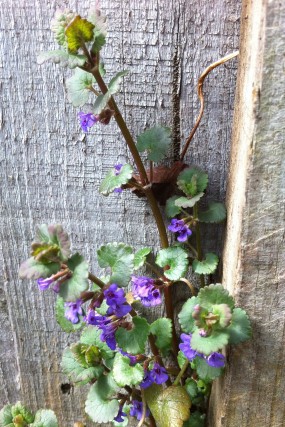Ground Ivy, “The Deceiver” – but a useful one!
As a herbalist, I often find my gaze wandering to all that is green – and potentially medicinal – growing about my feet. I was smiling to myself as I walked along a suburban footpath this afternoon, registering how much growth there has been in the past couple of weeks, when I suddenly stopped short at the sight of what I thought looked like some sort of miniature sweet violet. In fact, it was nothing of the kind. Like so many before me, I had been deceived by a pretty herb called Ground Ivy (Glechoma hederacea). No wonder it has gone down in folklore as “The Deceiver”! I was far from disappointed when I took a closer look and realised my mistake, as it’s a very useful herb that I like to have in my dispensary.
Like so many before me, I had been deceived by a pretty herb called Ground Ivy (Glechoma hederacea). No wonder it has gone down in folklore as “The Deceiver”!
The aerial parts of this pretty, low-growing plant, which is often found on woodland floors and wasteground, have long been used to treat catarrh and other disorders of the mucous membranes of the ears, nose and throat. In 16th Century it was considered a valuable remedy for tinnitus and more recently, in the laboratory, it has been found to have antibacterial and antioxidant activity. Despite not being particularly rich in tannins, an infusion of the plant displays astringent properties and herbalists may therefore sometimes use it for gastrointestinal disorders such as diarrhoea or gastritis. The plant contains flavonoids which are anti-inflammatory and its volatile oil content becomes apparent when its leaves are rubbed it gives off a strong and not unpleasant smell. Perhaps this, along with its bitter principle, glechomine, is why it was used to flavour and clarify ale until the introduction of hop-use in the 16th Century.
I didn’t pick the plant I found today, as the footpath was too well-trodden by our canine friends (!), but I shall be on the look out for more of this “Deceiver” as Spring continues to awaken this enchanting herb from its wintry sleep.
Safety Notes: Always ID plants correctly before picking in the wild. If you have a health condition, please seek advice from a medical herbalist or other health professional before self-medicating.
References:
Bartram, T. (1998). Bartram’s Encyclopedia of Herbal Medicine. London: Robinson.
Chevallier A. (2000). Encyclopedia of Herbal Medicine’ (2nd ed.). NY: Dorling Kindersley.
Fisher, C. (2009). Materia Medica of Western Herbs. Nelson: Vitex Medica.
Hatfield, G. (2007). Hatfield’s Herbal: A Secret History of British Plants. London: Penguin Books.

